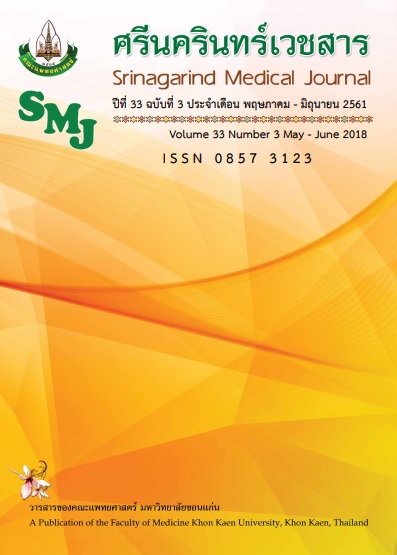Incidence of Tube Changing when Using Motomoya Formula for Calculation of Cuffed Endotracheal Tube Size in Pediatric Patients
Abstract
Background and objectives: Cuffed endotracheal tube has been proven as safe to use in pediatric population. Two formulae have been proposed for calculation of tube size of cuffed endotracheal tube: Motomoya’s formula [(Age/4) +3.5] and Khine’s formula [(Age/4) +3.0]. However, it is not clear which formula is appropriate for calculation of endotracheal tube size. The present study aimed to investigate the frequency of tube exchange to a smaller tube size when starting tube size is calculated using Motomoya’s formula.
Methods: Fifty pediatric patients who had been scheduled for elective surgery under general anesthesia were recruited. Inclusion criteria were: age between 2 to 10 years old, and ASA physical status 1 or 2. Exclusion criteria were increased risk of pulmonary aspiration or difficult airway. Cuffed endotracheal tube size was calculated using Motomoya’s formula and patients were intubated by experienced anesthetic personnel using direct laryngoscopy. (Tube size 4.0 for age 2-3.5 years old, size 4.5 for 3.5-5.5 years old, size 5.0 for 5.5-7.5 years old, size 5.5 for 7.5-9.5 years old and 6.0 for 9.5-10 years old.
Results: All patients were successfully intubated. None required exchanging to a smaller tube size. Mean end tidal CO2 was 34.1± 2.43 mmHg. Mean of peak airway pressure was 16.86± 3.86 cm H2O. None of the patients had complications related to intubation in two days after the operation.
Conclusion: Motomoya’s formula is appropriate as a starting formula for cuffed endotracheal tube size in pediatric population.
อุบัติการณ์ของการเปลี่ยนท่อช่วยหายใจเมื่อใช้สูตรโมโตโมยาในการคำนวณขนาดท่อช่วยหายใจแบบมีกระเปาะลมสำหรับผู้ป่วยเด็ก
อธิพงศ์ พัฒนเศรษฐพงษ์*, พญ.ธิตินุช รื่นหรรษา
ภาควิชาวิสัญญีวิทยา คณะแพทยศาสตร์ มหาวิทยาลัยขอนแก่น ถนนมิตรภาพ อ.เมือง จ.ขอนแก่น 40002
หลักการและวัตถุประสงค์: ปัจจุบันท่อช่วยหายใจแบบมีกระเปาะถูกพิสูจน์แล้วว่าปลอดภัยสำหรับผู้ป่วยเด็ก โดยมีสูตรคำนวณคือสูตรของ Motomoya [(อายุ/4) +3.5] และสูตรของ Khine [(อายุ/4) +3.0] ทว่าในปัจจุบันยังไม่มีความชัดเจนว่าสูตรใดมีความเหมาะสมในการคำนวณขนาดท่อช่วยหายใจ การศึกษาครั้งนี้จึงมีวัตถุประสงค์เพื่อศึกษาอัตราการต้องเปลี่ยนท่อช่วยหายใจไปเป็นขนาดเล็กลงเมื่อใช้สูตรของ Motomoya
วิธีการศึกษา: ผู้เข้าร่วมการศึกษาเป็นผู้ป่วยเด็กจำนวน 50 ราย ที่มีแผนเข้ารับการผ่าตัดแบบไม่เร่งด่วนด้วยการระงับความรู้สึกทั่วตัว เงื่อนไขในการเข้าร่วมคืออายุระหว่าง 2 ถึง 10 ปี และ ASA physical status 1 หรือ 2 เงื่อนไขในการตัดออกคือความเสี่ยงต่อการสำลักอาหารหรือภาวะใส่ท่อช่วยหายใจยาก ขนาดท่อช่วยหายใจคำนวณโดยใช้สูตรของ Motomoya และการใส่ท่อช่วยหายใจทำโดยบุคลากรทางวิสัญญีผู้มีประสบการณ์ด้วยการดูกล่องเสียงโดยตรง (ขนาดท่อที่ใช้คือ 4.0 สำหรับอายุ 2 – 3.5 ปี ขนาด 4.5 สำหรับอายุ 3.5-5.5 ปี ขนาด 5.0 สำหรับอายุ 5.5 – 7.5 ปี ขนาด 5.5 สำหรับอายุ 7.5-9.5 ปี และ 6.0 สำหรับ 9.5 – 10 ปี)
ผลการศึกษา: สามารถใส่ท่อช่วยหายใจให้ผู้ป่วยได้ทุกคน ไม่มีผู้เข้าร่วมที่ต้องเปลี่ยนเป็นท่อช่วยหายใจขนาดเล็กลง ค่าเฉลี่ยของคาร์บอนไดออกไซด์ ณ จุดที่หายใจออกสุดคือ 34.1 ± 2.43 มม.ปรอท ค่าเฉลี่ยความดันทางเดินหายใจสูงสุดคือ 16.86± 3.86 ซม.น้ำ ผู้เข้าร่วมทุกคนไม่มีภาวะแทรกซ้อนจากการใส่ท่อช่วยหายใจในช่วงสองวันหลังการผ่าตัด
สรุป: สูตรของ Motomoya เหมาะสมที่จะเป็นสูตรคำนวณสำหรับท่อช่วยหายใจแบบมีกระเปาะในผู้ป่วยเด็ก
References
2. Clements R, Steel A, Bates A, Mackenzie R. Cuffed endotracheal tube use in paediatric prehospital intubation: challenging the doctrine? J Accid Emerg Med 2007; 24: 57–8.
3. Dorsey DP, Bowman SM, Klein MB, Archer D, Sharar SR. Perioperative use of cuffed endotracheal tubes is advantageous in young pediatric burn patients. Burns 2010; 36: 856–60.
4. Eschertzhuber S, Salgo B, Schmitz A, Roth W, Frotzler A, Keller C, et al. Cuffed endotracheal tubes in children reduce sevoflurane and medical gas consumption and related costs. Acta Anaesthesiol Scand 2010; 54: 855–8.
5. Motoyama EK. Endotracheal intubation. In: Motoyama EK, Davis PJ, editors. Smith’s anesthesia for infants and children. 5th ed. St. Louis: CV Mosby; 1990: 272–5.
6. Khine HH, Corddry DH, Kettrick RG, Martin TM, McCloskey JJ, Rose JB, et al. Comparison of cuffed and uncuffed endotracheal tubes in young children during general anesthesia. Anesthesiology 1997; 86: 627–31.
7. Hanley JA, Lippman-Hand A. If nothing goes wrong, is everything all right? Interpreting zero numerators. JAMA 1983; 249: 1743–5.
8. Altun D, Orhan Sungur M, Ali A, Özkan Seyhan T, Sivrikoz N, Çamcı E. The role of ultrasound in appropriate endotracheal tube size selection in pediatric patients. Pediatr Anesth 2017 ; 27: 1015-20.




